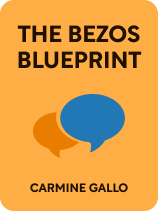

This article is an excerpt from the Shortform book guide to "The Bezos Blueprint" by Carmine Gallo. Shortform has the world's best summaries and analyses of books you should be reading.
Like this article? Sign up for a free trial here.
When you communicate, are you clear on what your big idea is? Does your audience have clarity? What is the main point of what you’re saying?
If you’re not sure, you might appreciate learning how Amazon communicates. In The Bezos Blueprint, Carmine Gallo helps you identify your main point and then communicate it effectively using the structure of a press release.
Continue reading to learn how to get your main point across.
What Is the Main Point?
One of the reasons you should communicate simply is to reduce the work your audience needs to do to understand you. One way to reduce the work for your audience is to get to the point as quickly as possible. Gallo explains that all Amazon communications state the most important takeaway up front. Your audience’s time is precious. We’ll show you how to respect it by telling them right away what you have to say and why it matters to them.
(Shortform note: In The Pyramid Principle, Barbara Minto adds that if you don’t start with your main point, you force readers to reach conclusions on their own as they read, which overburdens them and leads to potential misinterpretation. Like Gallo, she recommends stating your conclusion first, then walking readers through your reasoning. Minto says this approach doesn’t come naturally to most writers because the typical writing process leads you to your main point last: You write out your ideas, consider the relationships between them, then add a conclusion to summarize the point you’ve made.)
Determine Your Main Point
Obviously, to follow this advice, you first need to figure out what your takeaway is. If your audience gleans one thing from your communication, what should that be? What is the main point you want to get across? Make this one thing as clear and simple as possible. Make sure it’s obvious why it matters to the listener. To do so, Gallo says, imagine an impatient listener asking, “Why should I care?” Then, answer this question three times, boiling down the answer each time until you’ve found the bottom line.
For example, to the customer’s question, “Why should I care about Amazon Prime’s shipping?” you might answer:
- Prime provides superior fulfillment services by combining an innovative approach to logistics with sophisticated demand forecasting. (This is too detailed and technical—what does it actually mean?)
- Prime predicts your purchases and gets items ready to ship and deliver efficiently. (This is better but still doesn’t get to the point—what’s the bottom line for the audience?)
- Prime gets you your stuff faster. (This grabs the audience’s attention by conveying what really matters to them.)
| More Ways to Get to the Point Saying why it matters is challenging: If you know enough about the topic to be speaking or writing about it, it’s probably already obvious to you why the topic matters—but it won’t be so obvious to an audience who’s just learning this information. Here are several suggestions that might help you follow Gallo’s suggestion to boil your message down to the bottom line: Give the bigger picture: Specialized or technical discussions can easily overwhelm readers and listeners with details like product specs and technical principles. Someone just learning about Prime doesn’t need to know how it does what it does, they need to know what it does and why it’s useful to them. Show how your idea disrupts the status quo: “Amazon focuses on the customer” might not seem like a particularly interesting insight, but if you note that, “While most 90s internet companies focused on the technology, Amazon focused on the customer,” it’ll be more obvious to your audience how this customer focus sets Amazon apart. Solve a practical problem: You might impress your audience by pointing out that there are millions of titles available on Kindle. But you’re more likely to make them care if you instead explain that whatever your taste in books, Kindle lets you find something you’ll like and start reading it immediately. |
Communicate Your Main Point
Once you’ve figured out what your main takeaway is, Gallo advises that you develop and explain the idea as though you were writing a press release for it. Start by stating the main idea and briefly explaining why it matters. Then describe the idea in more detail, explain what problem it addresses, and how it solves that problem. End by sharing hypothetical testimonials from your intended customers or partners. This last step forces you to think more closely about how your idea benefits its target audience.
Gallo explains that, at Amazon, proposals for new products, services, and other ideas take this mock press release form. This approach forces presenters to focus on the ultimate vision and make it compelling. Instead of pitching a project with research and data, starting with the press release forces you to think about your ultimate takeaway point and why it matters to the average person. Once that vision is clear, you can work backward to figure out what you need to do to get there.
Gallo identifies two benefits to this approach:
- It forces you to think through and refine your ideas. You’ll have to be absolutely clear about what your finished idea will look like, how it’ll work, and who’ll care about it. Sloppy or incomplete thoughts will be obvious.
- Because a press release aims at selling the new idea to the general public, it’ll make your pitch as simple and compelling as possible—which raises your chances of convincing executives, investors, or partners to get on board.
| Don’t Stifle Innovation by Aiming for a Press Release Too Early While starting with the press release can be a powerful tool because it forces you to think about your end goal early on, some experts warn that focusing on an end goal too early can stifle innovation. For example, Nassim Nicholas Taleb argues in Antifragile that most of the world’s greatest inventions have come from tinkering—experimentation without a specific outcome in mind—and many discoveries have come from mistakes and happy accidents. However, Taleb says, many investors (especially government investors) only fund research aimed at specific, predefined goals. This practice eliminates tinkering and, Taleb says, greatly reduces the chances of progress. That’s not to say that mock press releases inherently quash innovation. Instead, Taleb’s insight suggests the importance of giving your innovators the time and resources to tinker without an end goal or a big picture in mind. Once they have an idea they’re ready to pitch, then they can apply the press release strategy to refine the idea and articulate its benefits so as to best position it to investors and others. |

———End of Preview———
Like what you just read? Read the rest of the world's best book summary and analysis of Carmine Gallo's "The Bezos Blueprint" at Shortform.
Here's what you'll find in our full The Bezos Blueprint summary:
- How to improve your communication by using Jeff Bezos's principles
- Why you should start a project with a press release
- Why you should ban PowerPoint in favor of storytelling






